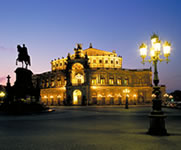The Mining Museum in Bochum was established in 1930 and is widely regarded as the foremost museum of its type. It is also the world's leading research institute for the history of the coal and steel industries. The 12,000m˛ site gives visitors a complete picture of mining around the world from prehistoric times to the modern day. The centrepiece of the museum that attracts large numbers of visitors is the authentic visitor mine beneath the site. Visitors descend 20 metres underground by lift. The 2.5 kilometre underground tour takes in numerous shafts, different conveyor belts, scoops and gigantic drilling machines. Guided tours are available, closed on Mondays and 24, 25, 26 & 31 December, 1 January and 1 May.
» www.bergbaumuseum.de
The East Bavarian Mining and Industrial Museum was established in 1978 in Hammerherren Mansion, built in 1781. It is a museum of national importance that researches, documents and illustrates mining and industry in the whole eastern Bavarian region. Three monuments to regional industry have also been relocated to Theuern - an iron hammer mill, a mine shaft and a glass grinding and polishing works, which has housed the East Bavarian Electricity Museum since 1996. Guided tours on request. Closed on Mondays and from 20 December to 20 February.
» www.museumtheuern.de
The four themed areas of the Hessen Lignite Mining Museum show visitors the fascinating history of brown-coal mining in Hessen from the 16th century onwards. The oldest half-timbered building in the town of Borken houses a permanent exhibition covering the 400-year history of mining here, including the development of the coalfield, the use of brown coal as a factor in industrialisation and the social conditions of the mineworkers. The rest of the museum consists of an open-air exhibition site, a nature conservation centre and a visitor mine. Special exhibitions are also staged. Guided tours on request, closed on Mondays and from November to March.
» www.braunkohle-bergbaumuseum.de
The most unusual visitor mine in the Black Forest traces 800 years of mining history. The mine workings were sunk into Schauinsland mountain near Freiburg to explore for silver, lead and zinc. The tunnels are about 100 kilometres in length, on 22 levels, making this the biggest mine in the Black Forest. At the beginning of the 20th century 250 miners worked here. Guided tours provide visitors with insights into all aspects of ore mining. Since 1975, the Barbarastollen shaft has been used by the German Federal Office of Administration as a storage site for state archives copied onto reels of film. Closed November to May.
» www.schauinsland.de
This salt mine dating back to 1517 in the picturesque town of Berchtesgaden is the only working salt mine open to the public. Expert guides take visitors along a route beneath the earth, passing through impressive underground chambers where an informative film about extracting the "white gold" is shown and a wealth of fascinating artefacts are on display. Visitors dress in traditional miners' clothes and ride the pit train along about 700 metres of track into the mysterious world inside the mountain. The tour of the mine culminates with a raft ride across a glittering underground saltwater lake. Old miner's lamps, tools, equipment and the display cases in the salt museum give visitors an insight into the work of the mine, past and present. Closed 1 January, Shrove Tuesday, Good Friday, Whit Monday, 1 November, 24, 25 & 31 December.
» www.salzwelt.de
The fortunes of the town of Lüneburg rested on salt extraction for more than a thousand years. Production ceased in 1980 and the German Salt Museum/Lüneburg Saltworks Industrial Monument opened on the site of the saltworks in 1989. The industrial monument, which was one of the first of its kind, is located in the boiling house, built in 1924, and the museum site also includes the Well House (1832), the Donkey Stable (1850), a brine tank and part of the remains of the town walls which surrounded the saltworks. The museum tells the story of Europe's oldest and once largest salt production plant. In the exhibition buildings state-of-the art multi-media technology is used to illustrate the history of salt, the importance of salt for people today and in the past and different salt production methods. The subjects covered by the exhibition areas include: salt in general, the 20th century, the 19th century and the Middle Ages & early modern period. Guided tours on request.
» www.salzmuseum.de
Zinngrube Visitor Mine and Museum was established after mining ceased in Ehrenfriedersdorf in 1990. Visitors to the museum can find out all about ore mining in the Erzgebirge mountains. Located in the oldest tin-mining region in Germany, Zinngrube Visitor Mine traces the development of working methods from the Middle Ages to the late 20th century. The museum provides a wealth of fascinating geological information and houses a collection of more than 1,000 different minerals, models illustrating the history of the mine and other finds. 1,500 metres of mine workings 100 metres underground are accessible to visitors on guided tours, and mining equipment is displayed and demonstrated underground. Part of the mine is used for medicinal purposes. Closed on Mondays – except on public holidays – and on 24, 25 & 31 Dec. and 1 Jan.
» www.zinngrube.de



